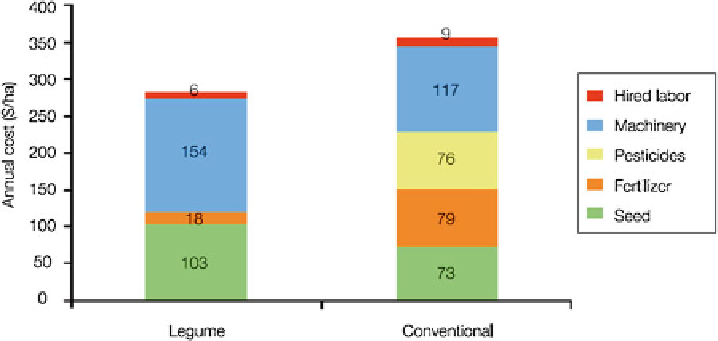Agriculture Reference
In-Depth Information
Fig. 13.14
Annual input costs for the legume and conventional grain rotations (Kimble et al.
2007
)
becomes relatively more on per unit of crop
production bases (Smith et al.
2007
).
• Quality of organic-grown produce is often
lower due to insect damage, which is less in
conventional agriculture with its use of
pesticides.
• Highly dependent on nutrients derived from
livestock
Organic agriculture requires 28-32 % less
energy compared to conventional systems. Input
costs for seed, fertilizer, pesticides, machinery,
and hired labor are approximately 20 % lower in
a rotation that includes a legume compared with
a conventional rotation system (Fig.
13.14
)
(Kimble et al.
2007
).
In the Eastern African Highlands, animal
manure application leads to 2,820 kg ha
−1
year
−1
carbon inputs with $156 per ha cost and 5.5 %
carbon sequestration effi ciency (Woomer et al.
1998
). The sequestration of one ton of soil
carbon using cattle manure requires $260, but
return will increase by $1,066 (4.1 return ratio) as
a result of the addition. Some experts estimate the
cost of manure to be around $1,000, in which case
the additional returns would almost vanish. Maize
stover leads to 1,830 kg ha
−1
year
−1
carbon inputs
with $37 per ha cost and 5.4 % carbon sequestra-
tion effi ciency. The sequestration of one ton of
soil carbon using maize stover requires $374, but
this application also suppresses crop yields result-
ing in a loss of $112 (−1.3 return ratio).
Annual global sequestration potential of
organic agriculture amounts to 2.4-4.0 Gt CO
2
e
year
−1
, and it can be improved to 6.5-11.7 Gt
CO
2
e year
−1
by using new technologies in organic
agriculture (Smith et al.
2008
).
Organic agriculture has lower methane and
nitrous oxide emissions of 0.6-0.7 Gt CO
2
e
year
−1
in comparison to conventional agriculture,
which includes the burning of crop residue
(Smith et al.
2007
). Organic agriculture has a
signifi cant potential to provide on-farm energy
by biogas production from slurry and compost,
although this would detract from the quantities of
organic material to return to the soil.
If all agricultures were organic, the elimina-
tion of nitrogen fertilizers would save substantial
emissions. For example, in the case of UK, 1.5 %
of national energy consumption and 1 % of
national greenhouse gas emissions would be
saved (Mae-Wan Ho and Lim Li Ching
2008
).
Earlier studies showed that GHG emissions
would be 48-66 % lower per hectare in organic
farming systems in Europe. The lower emissions
were attributed to zero input of chemical N fertil-
izers, less use of high energy-consuming feed-
stock, low input of P (phosphorus) and K
(potassium) mineral fertilizers, and elimination
of pesticides. However, the productivity likely
would be lower.
Although not limited to organic farming, the
use of N from manure and compost or fi xed from

Search WWH ::

Custom Search